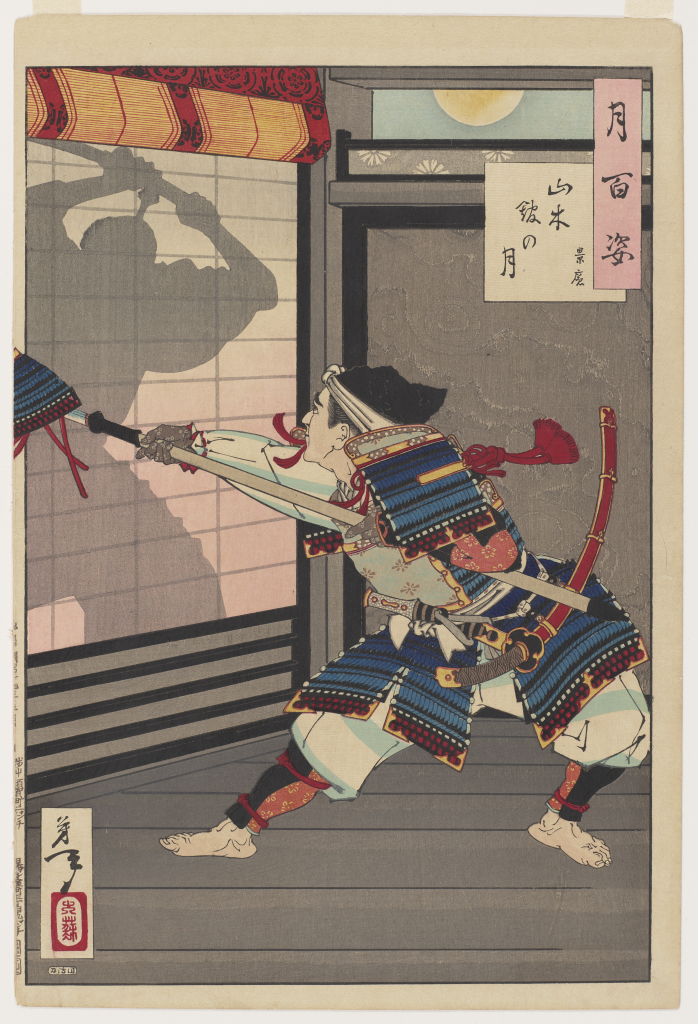Yamaki yakata no tsuki, Kagekado (The Moon of Yamaki Mansion, Kagekado), from the series Tsuki hyakushi (One Hundred Aspects of the Moon)

Tsukioka Yoshitoshi, Yamaki yakata no tsuki, Kagekado (The Moon of Yamaki Mansion, Kagekado), from the series Tsuki hyakushi (One Hundred Aspects of the Moon), 1886, March, color woodblock print on paper; ōban nishiki-e, Museum Purchase: Funds provided by the Asian Art Council and the Margery Hoffman Smith Fund, public domain, 83.44.91
This work is not currently on view.
- Title
Yamaki yakata no tsuki, Kagekado (The Moon of Yamaki Mansion, Kagekado), from the series Tsuki hyakushi (One Hundred Aspects of the Moon)
- Related Titles
original language: 山木館の月 景廉
series (original language): 月百姿
series (translated): One Hundred Aspects of the Moon
series (transliterated): Tsuki hyakushi
translated: The Moon of Yamaki Mansion, Kagekado
transliterated: Yamaki yakata no tsuki, Kagekado
- Artist
- Related People
carver: Noguchi Enkatsu (Japanese, 1826-1893)
publisher: Akiyama Bu'emon (Japanese, active Tokyo ca. 1882-1920s)
- Date
1886, March
- Period
Japan: Meiji period (1868-1912)
- Medium
color woodblock print on paper; ōban nishiki-e
- Catalogue Raisonné
Stevenson 1992, no. 27
- Dimensions (H x W x D)
image: 12 15/16 in x 9 in; sheet: 14 1/16 in x 9 7/16 in
- Inscriptions & Markings
publisher's mark; censor's mark: 日本バシ室町三丁目九バンチ / 組合 / 証 [trimmed], printed in black ink; printed in black intaglio within square cartouche; printed in black relief within square cartouche, left margin, bottom Transliteration (Translation): Nihonbashi Muromachi san-chōme kyū-banchi / kumiai / akashi ([at address:] Nishonbashi Muromachi 3-chōme 9-banchi; association certified) Language: Japanese Description: Partially trimmed seal of the publisher Akiyama Buemon 秋山武右衛門; Edo-Tokyo publisher, firm Kokkeidō 滑稽堂 active ca. 1882-1920s.
artist's seal: 浅草須賀町二バンチ [trimmed], printed in black ink, left margin, bottom Transliteration (Translation): Asakusa Suga-chō ni-banchi ([at address:] Asakusa Suga-chō 2-banchi) Language: Japanese Description: Partially trimmed seal of the artist Tsukioka Yoshitoshi.
carver's mark: 円活刀, printed in black ink within rectangular cartouche on reserve ground, bottom left Transliteration (Translation): Enkatsu tō ([seal of the carver Noguchi Enkatsu 野口円活]) Language: Japanese Description: Edo-Tokyo carver, 1826-1893.
date: 御届明治十九年三月 日 [trimmed], printed in black ink, left margin, center Transliteration (Translation): otodoke Meiji jūkyū-nen san-gatsu nichi (registered Meiji 19 [1886] March) Language: Japanese
artist's seal: 大蘇, printed in red relief within rectangular cartouche, lower left Transliteration (Translation): Taiso ([seal of artist Tsukioka Yoshitoshi 月岡芳年]) Language: Japanese
signature: 芳年, printed in black ink within rectangular cartouche on reserve ground, lower left Transliteration: Yoshitoshi Language: Japanese
title: 景廉 // 山木館の月, printed in black ink within square cartouche on reserve ground, upper right Transliteration (Translation): Kagekado // Yamaki yakata no tsuki (Kagekado, Moon of Yamaki Mansion) Language: Japanese
series title: 月百姿, printed in black ink within rectangular cartouche on pink ground, upper right Transliteration (Translation): Tsuki hyakushi (One Hundred Aspects of the Moon) Language: Japanese
- Collection Area
Asian Art; Graphic Arts
- Category
Prints
Japanese Traditional Prints
- Object Type
relief print
- Culture
Japanese
- Credit Line
Museum Purchase: Funds provided by the Asian Art Council and the Margery Hoffman Smith Fund
- Accession Number
83.44.91
- Copyright
public domain
- Terms
Like Utagawa Kuniyoshi's Yoritomo Raises His Flag: The Night Attack on Yamaki Castle [see Related Artworks], this work depicts the night attack on the Yamaki Mansion that took place in 1180. Yoshitoshi, the artist here, was a pupil of Kuniyoshi, who designed the triptych, and like him he was famous for his portrayals of warriors. He was surely aware of his master's work, yet he chose a very different approach to this well-known historical episode. He crops out much of the action to focus on a single figure. How do these artist's choices suggest different perspectives on history?
- Exhibitions
2013 Legendary Samurai Portland Art Museum









